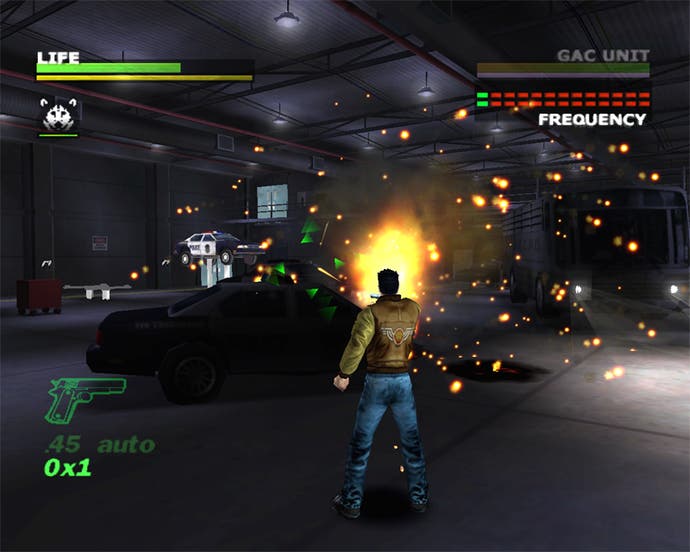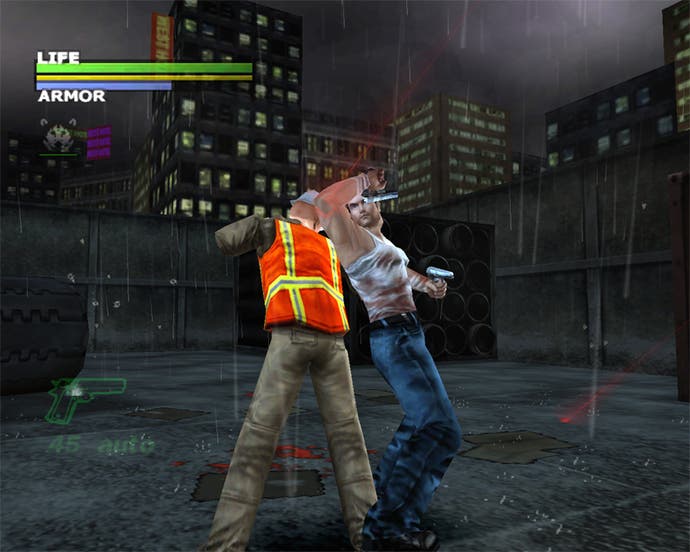Dead to Rights
Tom investigates The Bitmap Brothers' PC port of Namco's cop drama.
Amidst the filthy, crime-ridden corporate concrete monstrosities of Grant City, human beings aren't born; they're forged from broken bones and blood money. Which is rather poetic really, because Dead to Rights was forged from third-person action games and 3D beat-'em-ups. Murderous, sultry looking Jack "Of All Trades" Slate has always felt like an amalgam of cop clichés, most notably Max Payne with the revenge theme and Bullet Time (and you can easily imagine a sweaty, balding police chief snarling that "he breaks balls, but he gets results"), and in truth he's never sat comfortably for it.
Dead to Jumping

Very few third-person action games offer so much scope for violent interaction, but the fun of experimenting with such a vast range of abilities was often marred in the console versions by tedious tasks and unimaginative design. It's depressing, y'see, because Jack can do a hell of a lot, even by videogame standards. He can sidle up against walls, duck in and out of cover, dive around in slow motion and take hostages and kill hundreds of enemies in just a few minutes; shooting them with shotguns, machine guns, silenced pistols and plenty more, blowing them to pieces with exploding gas ganisters, clobbering them with his bare fists and feet, ripping their guns out of their hands and snapping their necks, and even sending his dog after them. When he's done with that, he can also collude with strippers to outfox bouncers, box, weight lift and even arm wrestle thanks to various rhythm-action mini-games.
But while Jack can handle all of that (and other stuff I've no doubt forgotten), he's hamstrung by a middle of the road third-person action game design, full of doors that cannot be opened, arbitrary and extremely contrived scripted events (the tutorial sets this up perfectly - apparently unable to climb over basic objects, supercop Jack gets his dog to knock down a handy ramp), back-and-forward level design, and a middling engine that looks and feels like Quake 2 era technology - something brought into sharp relief when it punches above its weight with a dazzling reflection effect. It's a game that, given the freedom of progress and attention to detail of a game like Prince of Persia (and, in fairness to the Namco team Stateside, probably a lot more development resources), could have been one of the finest action games of all time. But it never had the game to match up to its main character.
Remapped

Obviously Namco will be hoping that the forthcoming sequel can conjure up a more rounded and Max-paining experience that goes beyond Rockstar's powers of Remedy, but the original game still hasn't done too badly as it stands (notching up what must be around a million sales by now), and when I heard The Bitmap Brothers would be handling the PC port, suddenly there was this pang of excitement. They're not just porting it, they're updating it, I convinced myself. There's potential there.
And so there was. Happily enough, The Bitmaps have worked hard to justify their contract. In retrospect, they were hardly going to rebuild it from the ground up, so getting my hopes up was a bit foolish, but the result is still curiously gratifying. The same problems are present here - the draining and repetitive combat system that frustrates more than it ever excites, the substandard graphics engine (particularly significant on this platform) and the rather useless Shadow, and it still feels rather constrained by the lack of jumping, climbing and proper exploration. But being able to use keyboard and mouse together and re-map the keys (albeit outside of the game with no in-game options beyond sensitivity and inversion, which is remarkably lazy) is a crucial addition that gives you real breathing space.
With such a magnificently versatile central character, many of the buttons on a joypad end up doing two or three different things - in fact, following a string of beat-'em-up segments midway through playing the Xbox version, I actually had to redo the tutorial in order to remind myself of the shoot-'em-up mechanics - so being able to reconfigure things here makes a huge difference. This time, I rarely found myself struggling to remember how a particular function worked. Even better, those of you shaking your heads in disbelief can happily hook up a gamepad and play it that way. All that said though, one thing that did initially annoy me was the lack of Y-axis camera movement in general gameplay, although it was something I quickly got used to.
He ain't heavy

Beyond the controls, the Bitmaps hasn't really excelled itself, but the port is handled competently - there are more save slots (although the 16-slot limit is totally random in my eyes), higher resolutions, uncompressed textures and Dolby Digital 5.1 surround sound (which made it into the Xbox version but not, if I remember correctly, the PS2 and Cube variants), and amazingly given the piss poor quality of most console-to-PC fix-ups, performance is largely acceptable, even at high resolutions. Otherwise, besides a reportedly show-stopping bug that has been patched and didn't affect my progress anyway - despite my having the "right" graphics card for it - it's the same game as before.
The CG intro sequence sets it all up rather succinctly. Max, sorry, Jack is faced with... some sort of library under the control of terrorists. While trusty canine sidekick Shadow sweeps up remote bombs, Jack takes out several terrorists - rolling a CO2 canister up to them with "Freeze" written on the side, and then blowing it up, peppering them with bullets as he rides a bookshelf ladder along the wall, and then duking it out toe-to-toe with the chief bad guy in the basement, before grabbing his remote detonator and stopping the clock with three seconds left. Imagine a game version of that and you're roughly there. Just try not to imagine much room to deviate along the way; for the smoothly contoured CG combatants think sharp-angled identikit adversaries who all move at set angles and look vaguely robotic, and throw in a few bytes of dialogue here and there.
For the most part, it's about auto-targeting enemies and shooting them, sweeping up their weapons when they're gone, and repeating. Occasionally this segues neatly into some hand-to-hand combat (like when Jack is sent down for a murder he didn't commit, yadda yadda, and has to escape from Death Row through a sea of folks he helped put there), but you'll probably want to forget about these sections once you've fought your way through a few of them. Controls are simple WASD/mouse with a few action/function buttons thrown in for various reasons, and playing it feels relatively comfortable once you know how each move works.
Disarming

It sounds quite basic, but it does have some highlights - most notably the system of disarms, which are deceptively innocent sounding. Like The Mark of Kri (which nobody on the planet bought, probably rightly), there are some horrific ways to meet your maker when you come up against Jack and he wants your gun, whether it's having your weapon and hand dragged up behind your back so you can shoot yourself in the back of the head, or just having the gun popped out of your grasp and your neck snapped, and these are unlocked (seemingly rather randomly) throughout the game.
This does lead to a bit of a knife edge later on though, as whenever you find yourself weaponless you're faced with the prospect of some beautifully choreographed slaughter, or another stony faced trudge through the beat-'em-up motions. Still, fans of the macabre will obviously find some value in going back to search for more of these brutally entertaining special moves, and they are definitely the most emphatic and compelling thing about it all. Even better, Namco had the foresight to let you pick whether you concentrate on performing individual moves or just perform any old disarm at random. For those of you who couldn't care less about which way you kill somebody if the net result's the same, being able to randomise the move rather than being penalised for your lack of invention is a boon.
Another thing worth reiterating is that Dead to Rights is hard. Having polished off rather too many games this year without encountering serious resistance, feeling compelled to battle through and being forced to think about how I did it made a pleasant change. Replaying Dead to Rights on the PC, I genuinely had to sit and think about many of the latter sections, varying my use of human shields (another highlight), slow-motion movement, disarms and Time Crisis-style use of cover to better them. All right, it's mostly about the number of enemies rather than their level of intelligence (Halo this most certainly is not), but it was still challenging without being self-defeating. And there are now Rookie, Hard and Super Cop modes, so novices needn't whimper.
Disarmed
All that said, by Christmas 2003 Dead to Rights has aged rather poorly. It was originally released on Xbox over a year ago in the US and hasn't really changed to any great extent since then. It's been tweaked (repeatedly, actually), but in cop cliché terms it's still Dark Blue to Max Payne's Training Day. And in English, it lacks the style, glossy finish and gunslinging simplicity of Max, and particularly its unadventurous but hugely enjoyable sequel. It also lacks the narrative draw, even if it has the gravely voice and gritty banter. In short, it'll probably last you longer than Max Payne or Max Payne 2 (or both, if you play it thoroughly on Hard or Super Cop) and it has some good ideas, but at the end of the day it doesn't look, sound or handle as good. Next time out, it could do with less clichés and a more coherent, mould-breaking exhibition of its lead character's versatility. Hopefully that'll be Dead to Rights 2 in a nutshell.

